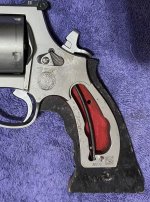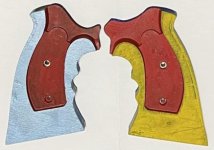Hello,
And yes, this is not really about standard trigger technique to be found on the thousands of websites searching for info (not about how far to put your fingertip over the trigger, angle degree of the upper two phalanges and to not yank etc.).
Searching for this on the internet is frustrating. Results are only about trigger technique, making me feel (a bit) like I am the only one on the world with this basic problem.
Actually it is about making it possible to use a good finger technique on a revolver.
All revolvers I shot with (S&W 617, S&W 686 and Ruger GP100), after cocking the trigger, the trigger is at the wrong place. It is too low and too close to my hand for my trigger finger.
It really sucks shooting this way, holding the grip on the place where the fingers should be (taking into account the finger grooves on the grip).
What works best for me is to lower my hand on the grip. This way I solve the two problems. The trigger is at the perfect height and, lower on the grip, my hand moves a bit away (back) from the trigger, resulting in the right angle for the two upper phalanges of the trigger finger.
I believe that this trick/workaround could help me overall, shooting with soft loads and making the best out of situation with the revoler in hand at that moment.
But when it comes to configuring your own revolver, there must be better ways to deal with this.
With the grip not meant to be hold this low, handling recoil is really bad. The revolver moves a lot after the shot.
This could cost points at matches and could be a bit problematic shooting heavy loads.
In case there is nothing to do about the placement of the trigger (as with a match pistol), only option is to fiddle with the grip.
For example.
Can a grip be lowered? Are there people who fill up the backside of the grip with putty? Are there grips specially made to solve this problem?
What are the options?




